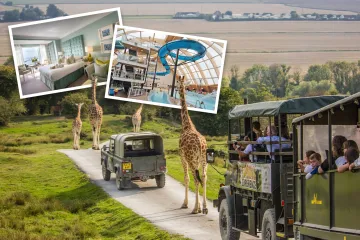The off-the-grid UK road trip that includes peaceful treehouses, quiet lochs and woodland trails
NESTLED in the Scottish highlands is an island like no other.
Think – vibrant trees that change colour as the seasons do, calm water with a gentle breeze skimming over the surface and cosy cabins with log burners in…
What you are picturing is Eilean Shona, an island in the Inner Hebrides that has no cars, no roads and no shops.
In fact, only nine people permanently live on the island.
To add to its beauty, the island even inspired J.M Barrie’s Neverland in Peter Pan.
Despite being a private island, visitors can still book to stay on the island and to get there, the residents have to come and collect you by boat.
Read more on travel inspo
Once on the island, you can indulge in the ultimate detox from the modern world by heading on hikes, including to the island’s summit and to white sand beaches.
And to add to the magic, a spirits brand was created on Eilean Shona.
Sun Travel spoke to Ed Faulkner, co-founder of Sapling about the brand and the story behind it.
If someone were to planning a restorative road trip in the UK, where should the top stops be?
A Sapling inspired road trip would celebrate quiet luxury, slow living and a deep connection with the natural world.
It could begin at Knepp Wildland in West Sussex, where rewilded meadows and roaming wildlife surround peaceful treehouses.
Then move on to the ancient beech canopy of Blackwood Forest in Hampshire with its inviting woodland trails.
From there, the journey might continue to the historic Blean Woods in Kent and the tranquil off grid cabins at Elmley Nature Reserve.
End among the ancient Caledonian pines that frame the still waters of Loch Tay in Perthshire.
Along the way, the spirit of the trip comes alive in the simple moments, such as enjoying a vodka or gin and tonic after a long walk with the people you care about.
It is a wholesome and grounding pause that brings everyone closer.
It reflects exactly what Sapling stands for, which is connection, presence and celebrating nature together.
For more inspiration about where to travel in the UK, these exciting new hotels, attractions and festivals coming to the UK’s seaside towns and cities next year.
Plus, our expert picks for UK staycation trips to banish post-summer blues – including free hidden gems for kids and £1.50 meals.
About Sapling
ED Faulkner, co-founder of Sapling, spoke to Sun Travel about the brand…
Scotland’s long been famous for whisky. What inspired you to choose vodka, and did Eilean Shona play a part in that?
We chose vodka because we saw an opportunity to redefine what new luxury means in a category that can often feel excessive and instead focus on purity, quality and creating a spirit that genuinely gives back.
Vodka, at its best, offers a sense of subtle refinement that fits perfectly with our climate-positive ethos.
Eilean Shona played a significant part in the birth of Sapling, as it was where Ed and Ivo (the other founder) first saw the purpose of the brand take shape while volunteering after wildfires destroyed one hundred and fifty thousand trees in 2017.
What makes Scotland such a special place to link to your vodka?
Scotland’s dramatic and restorative landscapes make it an ideal home for Sapling, because they reflect both our connection to nature and our mission to be climate positive.
Scotland is rich in untouched natural beauty and has long been seen as a place to escape the noise and excess of everyday life, which fits naturally with our idea of new luxury.
Since starting Sapling, have you seen spirit tourism become more popular?
Yes, we have seen a clear rise in spirit tourism, driven by people wanting deeper and more authentic experiences that connect them to the provenance and purpose of what they drink.
How does your vodka help consumers connect to Scotland and nature?
Sapling helps people feel connected to Scotland and nature through our one bottle one tree initiative, which ensures that every purchase directly contributes to climate restoration across the UK.
This gives drinkers a tangible link to the landscapes that inspire us.
Have you found it hard to break into the vodka market?
Vodka felt natural for us because it aligns with the idea that first inspired the brand, which was the blend of reforestation by day and celebration by night.
Our founders also felt that the vodka category was ready for change, as traditional ideas of luxury in vodka have often centred on excess and nightlife.



